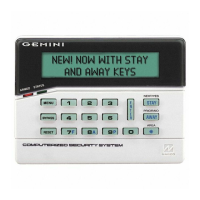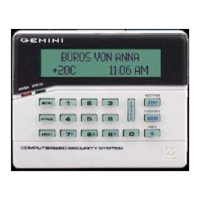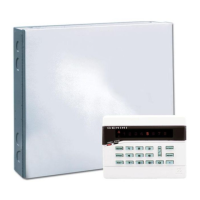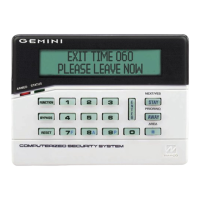NAPCO Gemini C-Series Control Panel Installation Instructions--Volume 2
Page 36 Installation Instructions, Volume 2
FIRE GLOSSARY
initiated PCPreset connections.
Telco Fail See Enable Telephone Line-Fault Test
Telco Line 1 Failure; Telco Line 2 Failure see Enable Telephone Line 1 Fault Test
Telephone Numbers
Dialing Prefix
To report to a central station, Telephone Number 1 must be programmed. Telephone Number 2 is programmed for
Backup Reporting; Telephone Number 3 is programmed for Dual or Split Reporting.
Private telephone systems may require a Dial-Tone Detection "E" or Pre-Dial Delay "D", followed by an access number to ob-
tain an outside line. (See Access Number for Outside Line.)
It should be noted here that the telephone number need not actually start in the first location shown, and may not end in the
last. Extra locations have been provided to allow for one or more prefix digits: a Pre-Dial Delay "D" or a Dial-Tone Detection
"E". What is important is that the telephone number, with its associated Pre-Dial Delay, Access Number, and Dial-Tone
Detection, be wholly contained within that group of locations, and that they be in their proper sequence.
If needed, a Dialing Prefix of up to 20 digits may be programmed. This prefix will be dialed immediately before the pro-
grammed central station telephone numbers.
Test Timer
The test timer schedule is programmed using NAPCO's PCD-Windows Quickloader Software. If Test Timer is programmed,
an automatic test report will be transmitted to the central station on the scheduled day(s) at the scheduled time. (UL installa-
tions require a report at least every 24 hours). To report test timer, select Report Test Timer and program a report code.
Program the Test Timer event schedule and reporting time.
Time Zone
In the Quickloader Panel Selection screen, Time Zone tab, select the correct time zone for the control panel to ensure the
correct time is entered into the system.
TouchTone Dialing Only, Rotary Dialing Only, TouchTone Dialing with Rotary Backup (see the Burglary Glossary)
2-Wire, 4-Wire Smoke Detectors See Smoke Detectors
User Assignment
Controls user authority levels. The tabs are as follows:
User/System Codes
Type: Fire
When the Type column is selected for Fire, User codes may be added or changed; Area 1 (in the Area column) is
automatically selected. Note: A panel default Fire User Code is programmed as User #1, with digits 1234 active in
Area 1 only. In addition, all Fire User Codes must be at least 4 digits in length.
Type: Alarm
When the Type column is selected for Alarm (Burglary), User codes may be added or changed within Areas 2-8
(must be selected in the Area column). See User Code glossary entry below.
Type: Group
When the Type column is selected for Group (Enable ACM Access must be selected in the System Options tab of
the System Assignment screen), User codes may be added or changed within Areas 2-8 for the GEM-ACM1D
module (areas must be selected in the Area column). The Cards tab allows the addition of ACM access control
cards into the system, and assign these cards to Access Groups. See User Code glossary entry below and the
GEM-ACM1D installation instructions for more information.
User Reporting Open/Close
For each User Code added in the "User/System Codes" screen, the "User Reporting Open/Close" screen allows
you to enable or disable reporting for Telco 1 or Telco 3 openings and closings.
User Code (Burg User Code / Fire User Code)
In total, up to 195 Fire User and Burg User Codes may be entered into the system. A short description of each follows:
Fire User Code: This code is typically used by a person in authority to control the system after an alarm. For example, after
arriving at the premises, a fireman will likely need to access the system, investigate the number of alarms that occurred, de-
termine the part of the system that was affected, view events in the Fire log, etc. Another example of a person in possession
of a Fire User Code is the principal of a school who is required to initiate fire drills (the keypad has a "Do Fire Drill" selection).
The Fire User Code allows the ACK., SILENCE and RESET keypad buttons to operate, and allows other various "Function

